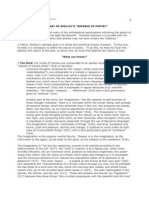Attribution Theory
Attribution Theory
Uploaded by
mak_90Copyright:
Available Formats
Attribution Theory
Attribution Theory
Uploaded by
mak_90Copyright
Available Formats
Share this document
Did you find this document useful?
Is this content inappropriate?
Copyright:
Available Formats
Attribution Theory
Attribution Theory
Uploaded by
mak_90Copyright:
Available Formats
ATTRIBUTION THEORY 1. 2.
Name of Theory: Attribution Theory Originator(s) and Professional Background: Attribution theory was developed overtime from the theories of Fritz Heider, Edward Jones, Keith Davis, and Harold Kelley. All were social psychologists. Edward 'Ned' Jones was born August 11, 1926 in Buffalo, NY. He received his doctorate degree from Harvard University in 1953. He taught at Duke University in the psychology department and was chair of the department from 1970-73. He was on both the National Science Foundation and National Institute of Mental Health's advisory boards. He has written several books including Foundations of Social Psychology. 3. Institution(s) with which identified: Harold Kelley was at the University of California and most of his research involving attribution theory was funded by the National Science Foundation. Edward Jones spent his entire career at the Duke University. 4. Purpose of the theory: Attribution theory is about how people make causal explanations; about how they answer questions beginning with "why?" The theory deals with the information they use in making causal inferences, and with what they do with this information to answer causal questions. The theory developed within social psychology as a means of dealing with questions of social perception. For instance, if a person is aggressively competitive in his/her behavior, is s/he this kind of person, or is s/he reacting to situational pressures. If a person fails a test, does s/he have low ability, or is the test difficult? In both examples, the questions concern the causes of observed behavior and the answers of interest are those given by the man on the street. This is why Heider refers to attribution theory as "nave" psychology. Attribution theory describes the processes of explaining events and the behavioral and emotional consequences of those explanations. Approximate year of origin: Heider first wrote about attribution theory in his book The Psychology of Interpersonal Relationships (1958) which played a central role in the origination and definition of attribution theory. Jones and Davis' systematic hypotheses about the perception of intention was published in 1965 in the essay "From Acts to Dispositions." Kelley published "Attribution in Social Psychology" in 1967.
5.
6. Circumstances that led to model development: In the 1970s the field of social psychology was dominated by attribution theorists and researchers. "Attribution theory came to rival cognitive dissonance as one of the most imperialistic theories in social psychology. Attribution theory was seen as relevant to the study of person perception, event perception, attitude change, the acquisition of self-knowledge, therapeutic interventions, and much more" (Ross and Fletcher, 1986). Attribution theory emerged from Heider's (1958) "nave" or "lay" psychology and
subsequent reformulations by Jones and Davis (1965) and Kelley (1967). Heider postulated a set of rules of inference by which the ordinary person might attribute responsibility to another person (an "actor") for an action. Heider distinguished between internal and external attributions, arguing that both personal forces and environmental factors operate on the "actor," and the balance of these determines the attribution of responsibility (Lewis and Daltroy, 1990). Kelley (1967) advanced Heider's theory by adding hypotheses about the factors that affect the formation of attributions: consistency, distinctiveness, and consensus. 7. Key terms: 1. Attributions - the causes individuals generate to make sense of their world. 2. Consistency - the degree to which the actor performs that same behavior toward an object on different occasions. 3. Distinctiveness - the degree to which the actor performs different behaviors with different objects. 4. Consensus - the degree to which other actors perform the same behavior with the same object. 8. Description of Attribution Theory: Heider's "Naive" Psychology: Heider believe that people act on the basis of their beliefs. Therefore, beliefs must be taken into account if psychologists were to account for human behavior. This would be true whether the beliefs were valid or not. Heider also suggested that you could learn a great deal from commonsense psychology. He stressed the importance of taking the ordinary person's explanations and understanding of events and behaviors seriously. Correspondent Inference Theory: Jones & Davis described how an "alert perceiver" might infer another's intentions and personal dispositions (personality traits, attitudes, etc.) from his or her behavior. Perceivers make correspondent inferences when they infer another's personal dispositions directly from behavior; for example, perceivers may infer a disposition of kindness from a kindly act. Inferences are correspondent when the behavior and the disposition can be assigned similar labels (e.g. kind). Kelley's Model of Attribution Theory: Kelley's theory is not limited to interpersonal perception. His theory concerns the subjective experience of attributional validity. He asks the question: "How do individuals establish the validity of their own or of another person's impression of an object?" Kelley suggested that perceivers examine three different kinds of information in their efforts to establish validity (Ross and Fletcher, 1985): Consensus information - do all or only a few people respond to the stimulus in the same way as the target person? Distinctiveness information - does the target person respond in the same way to other stimuli as well? Consistency information - does the target person always respond in the same way to this stimulus? Three combinations of this information: 1. High consensus, high distinctiveness, high consistency: The target person's judgment of the restaurant (it is a good restaurant) should be perceived as valid if the perceiver knows that 1) other people like the restaurant, 2) the target person seldom likes
restaurants, and 3) the target person enjoys the restaurant every time he or she goes there. The restaurant is good. 2. Low consensus, low distinctiveness, high consistency: If a perceiver knows that 1) most people do not like the target person's restaurant, 2) the target person likes most restaurants and 3) the target person enjoys the restaurant each time s/he goes there. Target person's enjoyment at restaurant attributable to something about him/her (likes to eat out) not something unique about the restaurant. 3. Low consensus, high distinctiveness, low consistency: If a perceiver knows 1) few other people like the restaurant, 2) the target person seldom likes the restaurant, and 3) the target person disliked this restaurant in the past. More than likely the target person's liking this restaurant is attributable to the person liking the company or wine rather than the food. 9. Attributions and Health Education Attribution theory can be applied to health education in 6 ways (Lewis and Daltroy, 1990): 1. development of therapeutic relationships between health care professionals and clients, 2. development of correct attributions, 3. alteration of incorrect attributions, 4. altering the focus of attributions, 5. attributing characteristics to the individual, and 6. maintenance of perceived personal effectiveness. References Heider, F. (1958). The Psychology of Interpersonal. Relations. New York: Wiley. Jones, E. E. and Davis, K. E. (1965). "From Acts to Dispositions: The Attribution Process in Person Perception." In L. Berkowitz (ed.), Advances in Experimental Social Psychology, vol. 2, Orlando, FL: Academic Press. Kelley, H. H. (1967). Attribution in social psychology. Nebraska Symposium on Motivation, 15, 192-238. Kelley, H. H. (1973). The processes of causal attribution. American Psychologist, 28, 107-128. Lewis, F. M. and Daltroy, L. H. (1990). "How Causal Explanations Influence Health Behavior: Attribution Theory." In Glanz, K., Lewis, F.M. and Rimer, B.K. (eds.) Health Education and Health Behavior: Theory , Research. and Practice. San Francisco, CA: Jossey-Bass Publishers, Inc. Ross, M. and Fletcher, G. J. O. (1985). "Attribution and Social Perception." In G. Lindsey & E. Aronson (eds.), The Handbook of Social Psychology, vol. 2, 73-114. Bibliography Boruchovitch, E. (1993, August). Causal attributions for health and illness: A cross-cultural contribution. Paper presented at the Annual Convention of the American Psychological Association, Toronto, Canada. Boutsen, F. R. (1991). Single-parent college students' attributions toward academic success. Psychology in the Schools, 28(4), 360-64. Fiedler, K. (1995). Actor-observer bias in close relationships: The role of self-knowledge and self-related language. Personality and Social Psychology Bulletin, 21(5), 525-38.
Fullen, C., & Mills, B. D. (1995, July). Attribution theory in sport: Problems and solutions. ERIC microfiche. Kilbride, M. P. (1989). Effectiveness of inservice attribution training of teachers. Unpublished master's thesis, University of South Florida, Tampa, FL. Magnusson, J., & Perry, R. P. (1992). Academic help-seeking in the university setting: The effects of motivational set, attributional style, and help source characteristics. Research in Higher Education, 33(2), 227-45. Wallace, S. R. & Thompson, T. E. (1995, October). Preservice teachers' changing attributions for elementary students success of failure. Paper presented at the Annual Meeting of the Mid-West Educational Research Association, Chicago, IL. Yan, W., & Gaier, E. L. (1994). Causal attributions for college success and failure: An AsianAmerican comparison. Journal of Cross-Cultural Psychology, 25(1), 146-58. Annotated Bibliography Baron, L. (May 1993). Narcissism, interpersonal adjustment, and coping in children of holocaust survivors. The Journal of Psychology, 127(3), 257-270. The article presents a study of children of holocaust survivors. The study utilizes several theories to explain certain personality characteristics of children of holocaust survivors. The children of the holocaust survivors completed a California Psychological Inventory, O'Brien Multiphasic Narcissism Inventory, and the Hardiness Scale. The specific characteristics which were being analyzed include the following: narcissism, interpersonal adjustment, and coping. The study applies attribution theory to examine why some children of holocaust survivors might express some of these personality characteristics. Desprels-Frayssee, A. (September, 1993). Referential set presentation effects on complementation by 6 year olds. Journal of Genetic Psychology, 154(3) 339-346. The article is a study of the meaning attributed by children to the properties of objects. The study is analyzed by the manner children respond to different complementation instructions. In this case, complementation refers to the differentiation of several objects by a set of common characteristics. The children of this age group in the study seem to find difficulty in differentiating objects with more than one characteristic. Thus, the study indicates the differences of attribution in interpretation by children. Maltby, J. (December 1996). Attribution style and projection. Journal of Genetic Psychology, 157(4), 505-507. The article is a very concise argument of a study comparing attribution theory and the psychoanalytic theory of the defense mechanism of projection. The study was performed by administering the Attribution Style Questionnaire and the Projections sub-scale of the Defense Style Questionnaire to a group of undergraduate students. The results of the study present no relation between the two theories. McClure, J. (April 1993). Discounting attributions and multiple determinants. The Journal of General Psychology, 120(2), 99-123. The author of this article is a well known social psychologist. He relates in this article the discounting principle in attribution theory and the changes that have occurred with respect to this principle. The article mentions the discrepancies among the empirical and theoretical basis of the
discounting principle. Recent research presents the new tendency of individuals to prefer multiple explanations rather than just one for a situation. The article also includes the aspect that in discounting, isolated causes and other associated causes exist. Then, the theories of Multiple Causation are explained and implemented to the case. Finally, two different case studies are presented, analyzed, and discussed. Scott, C. (June 1997). Gender and attribution of control over health and physical size. Journal of Social Psychology, (137) 387-389. The article presents a study of the differences of attribution attitudes between men and women. The study analyzed the discrepancies of genders attributing styles. The patterns of attribution by men and women of their personal success or failure is assessed. For example, the attribution of men and women to their success or failure in weight control. The study utilized a two-way analysis of variance, weight being the dependent variable. The conclusion of the short article suggests that the results of the study have implications for developing public health education campaigns. Witkowski, T. (April 1997). Performance level in situations of helplessness, threat, and group affiliation: egotistic mechanisms in helplessness deficits. The Journal of Social Psychology, 137(2), 229-235. The article utilizes the attribution theory to explain performance deficits resulting from learned helplessness. However, bad outcomes are usually denied responsibility, while positive outcomes tend to be accepted in order to reinforce self-esteem. According to the article, self-esteem could be threatened when the results are attributed to a person, and when the attribution is engaged to the individual's self-esteem. Finally, a study is presented which aims at explaining helplessness deficits or the lack of them by the attribution of egotism.
You might also like
- Theories in Social Psychology 2nd Edition PDFDocument22 pagesTheories in Social Psychology 2nd Edition PDFpihidaw541No ratings yet
- Three Major Counselling TheoriesDocument16 pagesThree Major Counselling TheoriesAlbert Muya Muraya100% (4)
- Applied Social PsychologyDocument13 pagesApplied Social PsychologyNeelambari Bhattacharya100% (1)
- Bozarth, Jerold D. - The Specificity Myth - The Fallacious Premise of Mental Health TreatmentDocument19 pagesBozarth, Jerold D. - The Specificity Myth - The Fallacious Premise of Mental Health TreatmentArinaDogaruNo ratings yet
- Humanistic and Experiential Theories of Psychotherapy PDFDocument32 pagesHumanistic and Experiential Theories of Psychotherapy PDFpsicandreiaNo ratings yet
- Psychodynamic Theory: Kathleen Holtz DealDocument12 pagesPsychodynamic Theory: Kathleen Holtz Dealsmacuja100% (1)
- Summary, Analysis & Review of Jonathan Haidt's The Righteous Mind by InstareadFrom EverandSummary, Analysis & Review of Jonathan Haidt's The Righteous Mind by InstareadNo ratings yet
- Andrew Chesterman: Questions in The Sociology of TranslationDocument40 pagesAndrew Chesterman: Questions in The Sociology of TranslationEsra Teker KozcazNo ratings yet
- Schrodinger's CatDocument4 pagesSchrodinger's CatAlexandra TeoNo ratings yet
- Attribution TheoryDocument3 pagesAttribution TheorypRiNcE DuDhAtRa100% (1)
- Hart 1991Document6 pagesHart 1991Dana PascuNo ratings yet
- Social Psychology: Attribution and Social ExplanationDocument71 pagesSocial Psychology: Attribution and Social ExplanationRomulobatoNo ratings yet
- Attribution (Psychology)Document7 pagesAttribution (Psychology)Lionel LimNo ratings yet
- Standard4 511Document17 pagesStandard4 511api-253724547No ratings yet
- Does Adlerian Theory Stand The Test of Time - Examining IndividualDocument13 pagesDoes Adlerian Theory Stand The Test of Time - Examining IndividualGladys VallenteNo ratings yet
- Personal Epistemology and Personal ExperienceDocument14 pagesPersonal Epistemology and Personal ExperienceChafik GraiguerNo ratings yet
- Adlerian Articlesin ACAEncyclopediaDocument6 pagesAdlerian Articlesin ACAEncyclopediarfaxel041No ratings yet
- Attribution Theory of Social PsychologyDocument3 pagesAttribution Theory of Social PsychologyDilip SirisenaNo ratings yet
- MR Femi assignm-WPS OfficeDocument14 pagesMR Femi assignm-WPS Officeoluwasegunsamuel009No ratings yet
- Carl Rogers Client Centered Therapy, Linda AgushiDocument6 pagesCarl Rogers Client Centered Therapy, Linda AgushiLinda AgushiNo ratings yet
- AttitudeDocument3 pagesAttitudeJananee RajagopalanNo ratings yet
- Individual Adlerian Psychology CounselingDocument5 pagesIndividual Adlerian Psychology CounselinghopeIshanzaNo ratings yet
- Society For The Scientific Study of Religion, Wiley Journal For The Scientific Study of ReligionDocument22 pagesSociety For The Scientific Study of Religion, Wiley Journal For The Scientific Study of ReligionPetruPavălNo ratings yet
- Psychometric Report For One Individual Using The IPIP and MSECQDocument15 pagesPsychometric Report For One Individual Using The IPIP and MSECQMalavika MenonNo ratings yet
- Neo-Five-Factor Inventory (NEO-FFI)Document22 pagesNeo-Five-Factor Inventory (NEO-FFI)rajpurkarpraj31No ratings yet
- DOC-20230123-WA0000 YuvrajDocument16 pagesDOC-20230123-WA0000 YuvrajAkshi chauhanNo ratings yet
- Locus of Control Practicumm: Aim: To Assess The Locus of Control of of An Individual UsingDocument16 pagesLocus of Control Practicumm: Aim: To Assess The Locus of Control of of An Individual UsingAkshi chauhanNo ratings yet
- Agency-An Empirical Model of An Abstract Concept-OJO OJO OJODocument45 pagesAgency-An Empirical Model of An Abstract Concept-OJO OJO OJOmlopez6No ratings yet
- R01 - Baldwin 1987 - Salient Private Audiences & Awareness of The SelfDocument12 pagesR01 - Baldwin 1987 - Salient Private Audiences & Awareness of The SelfGrupa5No ratings yet
- Social Perception and Cognition: B.A. I (Hon.), Lecture Series-1Document19 pagesSocial Perception and Cognition: B.A. I (Hon.), Lecture Series-1Alisha janiiNo ratings yet
- Attribution TheoryDocument8 pagesAttribution TheorySesame Bernoma100% (2)
- Beginning of Chapter 2Document103 pagesBeginning of Chapter 2mgaddafi20No ratings yet
- Keywords: Indigenized Psychology Physical Health, Religiosity, R-ScaleDocument23 pagesKeywords: Indigenized Psychology Physical Health, Religiosity, R-ScaleAndree JaiswalNo ratings yet
- Indigenous, Cultural, and Cross-Cultural Psychology: A Theoretical, Conceptual, and Epistemological Analysis Uichol KimDocument23 pagesIndigenous, Cultural, and Cross-Cultural Psychology: A Theoretical, Conceptual, and Epistemological Analysis Uichol KimUmmi LiyanaNo ratings yet
- Adlerian Articlesin ACAEncyclopediaDocument6 pagesAdlerian Articlesin ACAEncyclopediaTrisha May Dela PerreNo ratings yet
- Definitions of Attitude: Affect Behavior Cognition EmotionalDocument14 pagesDefinitions of Attitude: Affect Behavior Cognition EmotionalPriyanka Sharwan0% (1)
- Orders 128548Document4 pagesOrders 128548Ongiyo AustineNo ratings yet
- AttributionDocument2 pagesAttributionmayuripotdarNo ratings yet
- Humanistic Psychology and Contextual Behavioral PerspectivesDocument6 pagesHumanistic Psychology and Contextual Behavioral PerspectivesFelipe CrispinNo ratings yet
- Yuen 2010Document11 pagesYuen 2010Mega FitriNo ratings yet
- Social Psychology PDFDocument115 pagesSocial Psychology PDFDr. Deepti SharmaNo ratings yet
- Boyraz 2014Document9 pagesBoyraz 2014bordian georgeNo ratings yet
- Graham 2012 Liberals Implicitly Respond To Group Morality Before Rejecting It Explicitly (EEG)Document59 pagesGraham 2012 Liberals Implicitly Respond To Group Morality Before Rejecting It Explicitly (EEG)maría del pinoNo ratings yet
- A Multidimensional Approach To IndividualDocument20 pagesA Multidimensional Approach To IndividualdcaguenasNo ratings yet
- Authenticity Scale PDFDocument15 pagesAuthenticity Scale PDFIonelia PașaNo ratings yet
- Textual Notes - Social ProcessesDocument46 pagesTextual Notes - Social ProcessesSandesh WaghmareNo ratings yet
- Applied Social Psychology Module 1Document3 pagesApplied Social Psychology Module 1swathy sudheerNo ratings yet
- EDITED Bondy - Couns - Faith - IntegDocument10 pagesEDITED Bondy - Couns - Faith - IntegGary BNo ratings yet
- Chapter 3 PDFDocument14 pagesChapter 3 PDFLuthfi AccountingNo ratings yet
- What Is Cross Cultural PsychologyDocument13 pagesWhat Is Cross Cultural PsychologyFasihah LiewNo ratings yet
- Comsats Institute of Information Technology: PsychologyDocument8 pagesComsats Institute of Information Technology: PsychologyHaywire UmarNo ratings yet
- ReportDocument20 pagesReportShiele LipataNo ratings yet
- The Theory of Cognitive Dissonance (Article)Document11 pagesThe Theory of Cognitive Dissonance (Article)Quixote VerdeNo ratings yet
- Cognitive Dissonance TheoryDocument2 pagesCognitive Dissonance TheoryRavimohan RajmohanNo ratings yet
- The Big Five PersonalityDocument3 pagesThe Big Five PersonalityRabi'atul ApriantiNo ratings yet
- Reability and Validity of The Spanicsh Adaptation of Eoss ComparinDocument8 pagesReability and Validity of The Spanicsh Adaptation of Eoss ComparinSusana FossaNo ratings yet
- s11231 004 4324 ZDocument2 pagess11231 004 4324 ZNicole BautistaNo ratings yet
- Cognitive Dissonance TheoryDocument11 pagesCognitive Dissonance TheorymagarsafaikNo ratings yet
- Resource File and Personal TheoryDocument6 pagesResource File and Personal TheoryKimberly Smith100% (2)
- The Environment: Its Role in Psychosocial Functioning and PsychotherapyFrom EverandThe Environment: Its Role in Psychosocial Functioning and PsychotherapyNo ratings yet
- Social Perception: Detection and Interpretation of Animacy, Agency, and IntentionFrom EverandSocial Perception: Detection and Interpretation of Animacy, Agency, and IntentionNo ratings yet
- What Emotions Really Are: The Problem of Psychological CategoriesFrom EverandWhat Emotions Really Are: The Problem of Psychological CategoriesRating: 4.5 out of 5 stars4.5/5 (2)
- Ronald Dworkin Taking Rights SeriouslyDocument2 pagesRonald Dworkin Taking Rights SeriouslymartinNo ratings yet
- Block e - John Locke - Teo Ryesha Amina and Daniela RecoveredDocument12 pagesBlock e - John Locke - Teo Ryesha Amina and Daniela Recoveredapi-440375252No ratings yet
- American Atheist Magazine July 1986Document52 pagesAmerican Atheist Magazine July 1986American Atheists, Inc.No ratings yet
- The Importance of TrustDocument8 pagesThe Importance of TrustDharmaBoemiNo ratings yet
- Logical PositivismDocument30 pagesLogical Positivismangela danzalanNo ratings yet
- BhavanopanishadDocument2 pagesBhavanopanishadsrikaanth06100% (1)
- Challenges in Children's Literature TranslationDocument4 pagesChallenges in Children's Literature TranslationFrau YahiNo ratings yet
- Summary of Shelley'S "Defence of Poetry": Richard L. W. Clarke LITS2002 Notes 09 SupplementDocument4 pagesSummary of Shelley'S "Defence of Poetry": Richard L. W. Clarke LITS2002 Notes 09 Supplementstaima1980No ratings yet
- The Reconstruction of Religious Thought in Islam by Sir Muhammad IqbalDocument250 pagesThe Reconstruction of Religious Thought in Islam by Sir Muhammad IqbalMohammed Nasser100% (1)
- Analysing Religious Discourse - Stephen Pihlaja - 2021 - Cambridge University Press - 9781108836135 - Anna's ArchiveDocument380 pagesAnalysing Religious Discourse - Stephen Pihlaja - 2021 - Cambridge University Press - 9781108836135 - Anna's ArchiveMuhammad HabibieNo ratings yet
- Activity No. 1: Assessment 1. How Is Art and Philosophy Connected?Document2 pagesActivity No. 1: Assessment 1. How Is Art and Philosophy Connected?Kylene Edelle LeonardoNo ratings yet
- Review Martin Breaugh Expérience PlébéienneDocument6 pagesReview Martin Breaugh Expérience PlébéienneBruno Peixe DiasNo ratings yet
- Phaedrus, by PlatoDocument57 pagesPhaedrus, by PlatoOliver Davila ChasanNo ratings yet
- Who Is The God We Worship? Theologies of Disability Challenges and New PossibilitiesDocument35 pagesWho Is The God We Worship? Theologies of Disability Challenges and New Possibilitiesjimpetree6090No ratings yet
- Discourse Analysis and The Study of Communication in LIS: John M. BuddDocument18 pagesDiscourse Analysis and The Study of Communication in LIS: John M. BuddMaria Teresa CostamagnaNo ratings yet
- EAPP Q1 Week 78Document4 pagesEAPP Q1 Week 78Rebecca MarasiganNo ratings yet
- Thesis: Spare TireDocument150 pagesThesis: Spare TireRachael Tuico Abas100% (2)
- Ann Belford Ulanov - Madness and CreativityDocument136 pagesAnn Belford Ulanov - Madness and CreativityLFF57100% (2)
- Gender Studies Css MergedDocument14 pagesGender Studies Css MergedMir Mansoor TalpurNo ratings yet
- Martini Maha Maitri MeditationDocument73 pagesMartini Maha Maitri Meditationbyangsems100% (1)
- Richard H. Cox - Locke On War and Peace (1960)Document119 pagesRichard H. Cox - Locke On War and Peace (1960)Darinka NanbosNo ratings yet
- Maxim of Quantity PDFDocument4 pagesMaxim of Quantity PDFMax Dela TorreNo ratings yet
- Basic Ethical Principles in NursingDocument15 pagesBasic Ethical Principles in NursingMarceline RuizNo ratings yet
- Dr. AmmaraDocument6 pagesDr. Ammarawaqasidrees393No ratings yet
- Facebook For TeachingDocument252 pagesFacebook For TeachingVîrforeanu Nicolae AlinNo ratings yet
- Thesis EveryoneDocument34 pagesThesis EveryoneTanya KinigsteinNo ratings yet
- The Dead End of Dialogue by St. SunardiDocument7 pagesThe Dead End of Dialogue by St. Sunardiavatarrista309No ratings yet
- Text As Connected DiscourseDocument17 pagesText As Connected Discoursejho_olis90% (10)

























































































